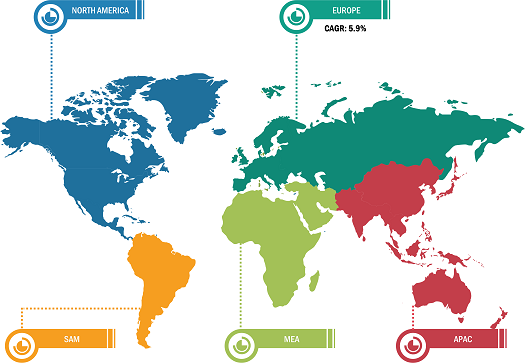Rapid Infrastructure Expansion Drives Synthetic Ester Lubricants for Construction Market Growth
According to our latest study on "Synthetic Ester Lubricants for Construction Market Forecast to 2031, Global and Regional Growth Opportunity Analysis – by Product Type and End Use," the market was valued at US$ 267.89 million in 2024 and is expected to reach US$ 382.99 million by 2031; it is estimated to register a CAGR of 5.4% during 2025–2031. The report highlights factors contributing to the growing synthetic ester lubricants for construction market size and prominent players, along with their developments in the market.
The construction industry is booming due to the government's efforts aimed at expanding infrastructure to support urbanization and drive economic growth. The US Infrastructure Investment and Jobs Act, which devotes more than one trillion dollars to improved infrastructure projects, such as roads, bridges, and transport infrastructure, is increasing the demand for heavy construction equipment that requires synthetic ester lubricants to perform optimally. Such lubricants have excellent thermal stability and coverage under high-stress conditions, which hold equipment durability and uptime. Also, developing economies in APAC are investing in smart city projects and transportation systems, adding to the increasing use of machinery. The increased lubrication prolongs the life of the equipment as it lowers the rates of wear and tear and the frequency of maintaining the equipment, assists in meeting the deadline of the project, and minimizes operational expenses incurred by the contractors. These factors are driving the synthetic ester lubricants for construction market growth.
Synthetic Ester Lubricants for Construction Market Breakdown – by Region
Synthetic Ester Lubricants for Construction Market Size and Forecast (2021 - 2031), Global and Regional Share, Trend, and Growth Opportunity Analysis Report Coverage: By Product Type (Engine Oil, Hydraulic Oil, Gear Oil, Grease, Turbine Oil, Metalworking Fluids, and Others) and End Use (Construction Machinery, Concrete and Construction Tools, Wire Ropes and Chains, and Others)
Synthetic Ester Lubricants for Construction Market Size 2031
Download Free Sample
The synthetic ester lubricants for construction market analysis have been performed by considering the following segments: product type and end use. By product type, the market is segmented into engine oil, hydraulic oil, gear oil, grease, turbine oil, metalworking fluids, and others. The hydraulic oil segment accounted for the largest synthetic ester lubricants for construction market share in 2024, due to the crucial role it plays in ensuring efficiency and reliability of the heavy construction machinery, including excavators, bulldozers, and loaders that often work at high pressure and in harsh conditions. Synthetic hydraulic oils, which are based on synthetic esters, have better biodegradability, wear resistance, and thermal stability as opposed to mineral oils, and therefore, they are critical in ensuring that construction equipment is maintained in life and meets the high environmental standards. Their mass application is driven by an increase in sustainability demands and increased use of environmentally acceptable lubricants in the construction industry.
The synthetic ester lubricants for construction market trends include rising demand for bio-based synthetic ester lubricants globally, integration of smart lubricants with IoT and data analytics, and increased focus on circular economy and recycling initiatives. The shift to bio-based and renewable feedstock-derived esters is influenced by the sustainability requirements of the world and the growing environmental consciousness. Bio-lubricants are actively encouraged by governments and non-profit organizations such as the US Department of Energy and the European Commission to decrease the carbon footprints and reliance on fossil-based resources.
Asia Pacific dominated the synthetic ester lubricants for construction market share in terms of revenue in 2024 due to fast industrialization, infrastructure development, and thriving manufacturing industries in countries such as China, India, Japan, and South Korea. The large government projects that surround the region, including the Belt and Road of China and the infrastructure development in India, boost demand for heavy machinery with related lubricants.
China Petroleum & Chemical Corp (Sinopec), Exxon Mobil Corp, BP Plc, Chevron Corp, Phillips 66, TotalEnergies SE, Valvoline Inc, Repsol SA, Fuchs SE, and Perstorp Holding AB are among the prominent players profiled in the synthetic ester lubricants for construction market report. These players are focusing on providing high-quality products to fulfill customer demand. They are adopting strategies such as new product launches, capacity expansions, partnerships, and collaborations to stay competitive in the market.
The synthetic ester lubricants for construction market is segmented based on product type, end use, and geography. Based on product type, the market is classified into engine oil, hydraulic oil, gear oil, grease, turbine oil, metalworking fluids, and others. In terms of end use, the synthetic ester lubricants for construction market is categorized into construction machinery, concrete and construction tools, wire ropes and chains, and others.
The geographical scope of the synthetic ester lubricants for construction market report focuses on North America, Europe, Asia Pacific, the Middle East & Africa, and South & Central America. The North America synthetic ester lubricants for construction market is segmented into the US, Canada, and Mexico. The market in Europe is categorized into Germany, France, Italy, the UK, Russia, and the Rest of Europe. The synthetic ester lubricants for construction market in Asia Pacific is segmented into Australia, China, India, Japan, South Korea, and the Rest of Asia Pacific. The Middle East & Africa synthetic ester lubricants for construction market is classified into South Africa, Saudi Arabia, the UAE, and the Rest of Middle East & Africa. The market in South & Central America is segmented into Brazil, Argentina, and the Rest of South & Central America.
Contact Us
Phone: +1-646-491-9876
Email Id: sales@theinsightpartners.com